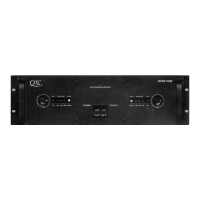28
iii. R57, D11 or R58, D14 in series are missing or bad
5. General or overall distortion
a. Before anything else, wiggle or otherwise check the input and output connectors for good
contact. If there is good contact, troubleshooting overall distortion can be tough since the cause
is sometimes buried instability, which is smoothed out by later stages. This can be checked by
probing the IC output and can be improved by using the stability procedures above.
b. Is the distortion odd (3
rd
order) or even (2
nd
order)?
i. Odd distortion indicates an equal problem on both sides of zero, normally a part
handling the full signal swing.
ii. Even harmonics indicate a mismatch between positive and negative, usually a bad part
on one side of the circuit.
c. If the distortion is still present with no load, look at feedback components, R7, R9, or IC input
circuitry. If it increases a lot for greater loads, something in the current carrying parts of the
output section is bad.
d. Possible causes of high frequency distortion:
i. The value of C3 is too high (x10?) for the slew rate compensation capacitor
ii. The base resistors, R15, R16, R17 or R18, on the output devices are missing (in this
case the amp usually draws excessive AC current near clipping, 20kHz, no load)
iii. Step distortion (see above)
Wrong Gain
1. Possible causes of gain that is too high:
a. One of the two feedback resistors may be missing from the output, R7 or R9
b. The input resistors, R1, R2, R3 or R4 may be the wrong value (faulty input resistors will fail the
common mode rejection test.
2. Possible causes of gain that is too low:
a. The feedback component values above are wrong
b. Shunt resistor, R8, with E4, is wrong or open (an open causes very low gain with instability;
check circuit board trace as well)
Poor Frequency Response (Correct any gain problems first.)
1. A high frequency response is determined by the input rolloff capacitor, C1, and feedback capacitor, C2
(a wrong value here will also cause instability).
2. A low frequency response is determined by DC feedback rolloff capacitor, E4, and the Butterworth
feedback network, C4 and R9 (see also gain section).

